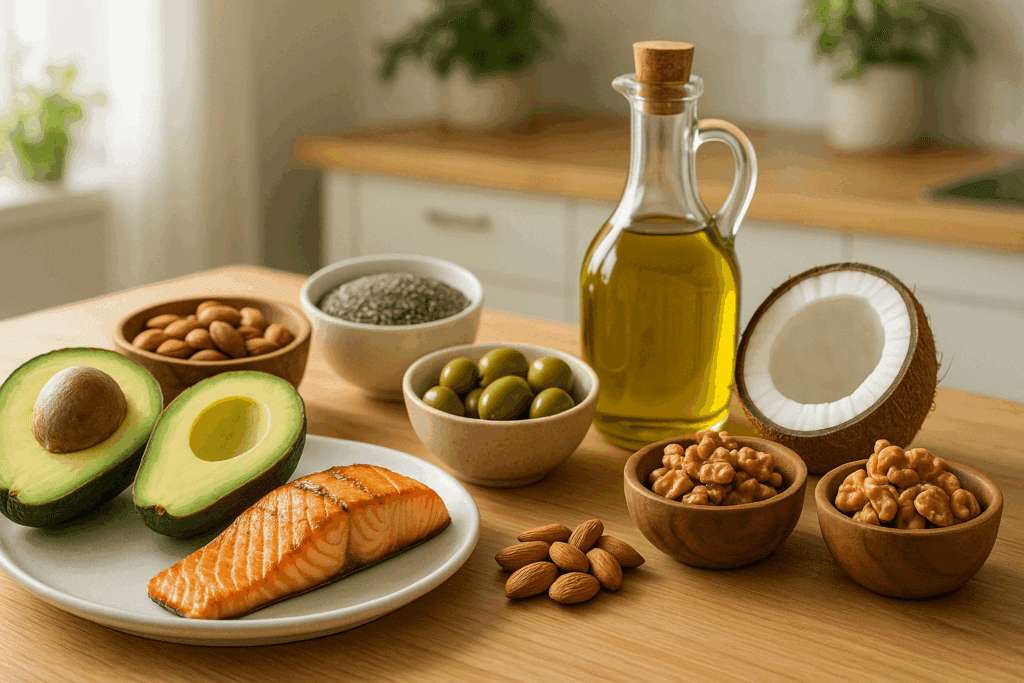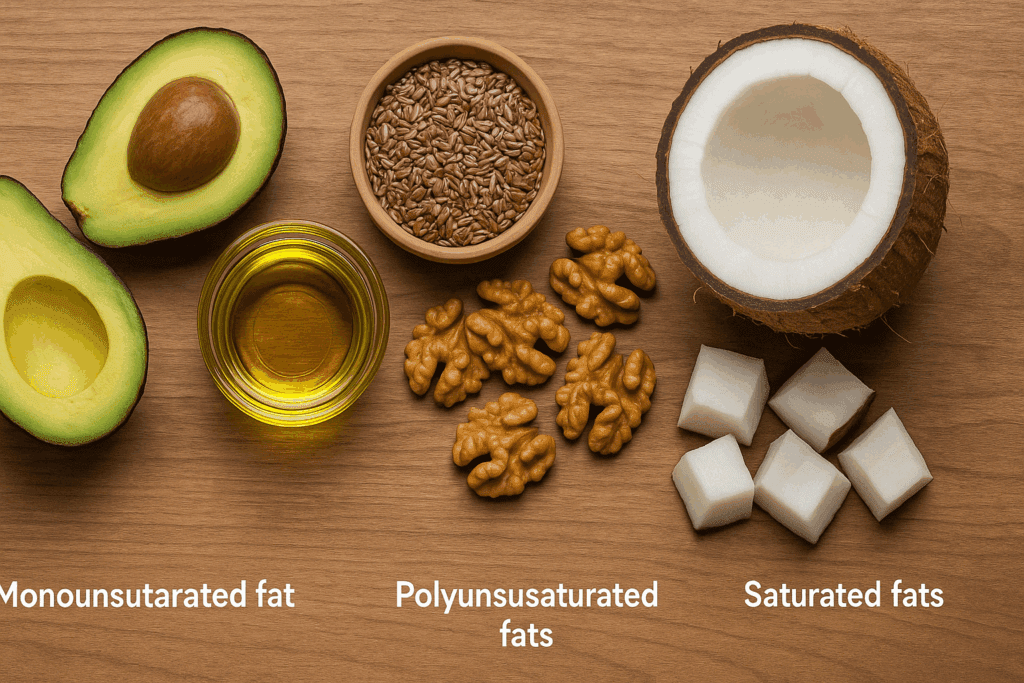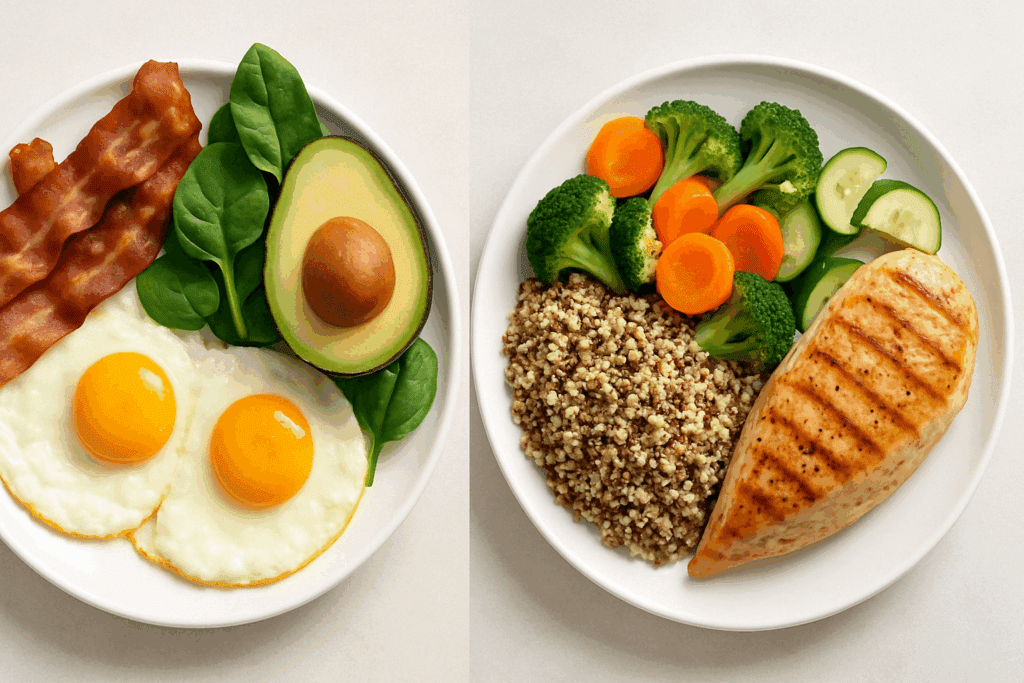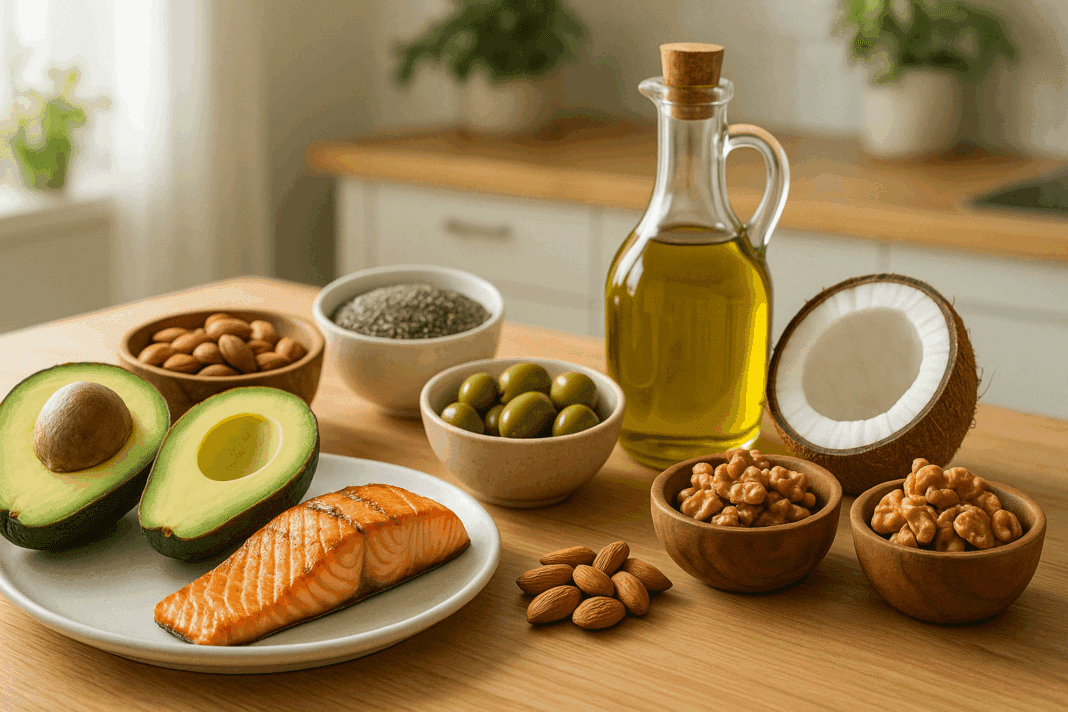In the world of nutrition, fat has long been unfairly maligned. For decades, popular culture and dietary guidelines painted fat as the dietary villain, responsible for everything from heart disease to weight gain. Yet in recent years, scientific research has flipped the script. Health experts now understand that fat is not only essential for human health but also a vital component of sustainable nutrition plans. The question is not whether to include fat in your diet, but how to do it wisely. If you’re interested in designing a high fat diet menu that supports long-term health, you’re in good company. Done correctly, a fat diet plan can promote satiety, support metabolic function, and even aid in weight management when appropriately balanced.
You may also like: Smart Meal Prep for Weight Loss: Expert-Approved Lunch Ideas and Recipes to Stay on Track
Understanding the Role of Fat in a Balanced Diet
Fat is one of the three macronutrients essential for human survival, alongside carbohydrates and protein. It plays critical roles in hormone production, nutrient absorption, brain health, and cellular structure. The body requires fat to absorb fat-soluble vitamins like A, D, E, and K. Importantly, not all fats are created equal. Monounsaturated and polyunsaturated fats, found in foods like nuts, seeds, avocados, and olive oil, offer protective health benefits, while trans fats and some saturated fats have been linked to adverse outcomes.
When crafting a high fat diet menu, it is essential to distinguish between beneficial and harmful fats. This dietary approach does not mean loading up on greasy fast food or processed snacks. Instead, it emphasizes whole, nutrient-dense sources of fat that align with evidence-based guidelines for optimal health. This is especially important when considering long-term sustainability and the growing interest in whether a high-fat, low-carb approach, such as the ketogenic diet, is suitable for all individuals. Questions like “is keto a good diet” or “is a keto diet sustainable” frequently surface, and the answers depend heavily on the types of fats and overall nutrient balance.

Debunking the Myths: Is Fat the Enemy?
The fear of fat largely stems from decades-old research that oversimplified the relationship between fat intake and heart disease. More recent meta-analyses have clarified that while certain fats, particularly trans fats, are indeed harmful, others are either neutral or beneficial. For example, a 2020 study published in the Journal of the American College of Cardiology highlighted that higher intake of healthy fats, particularly from plant sources, correlates with reduced cardiovascular risk.
This evolution in nutritional science has important implications for individuals exploring a fat diet plan. A diet rich in omega-3 fatty acids, for instance, has been shown to support cognitive health and reduce systemic inflammation. When balanced with moderate protein and low glycemic carbohydrates, high-fat diets can help manage insulin sensitivity and improve lipid profiles. This contrasts with older low-fat paradigms that often replaced fat with refined carbohydrates, inadvertently exacerbating metabolic issues.

Designing a High Fat Diet Menu with Nutritional Integrity
The cornerstone of a successful high fat diet menu lies in quality, not just quantity. A thoughtful fat diet plan includes a variety of whole foods that deliver more than just fat—they provide fiber, micronutrients, antioxidants, and anti-inflammatory compounds. Avocados, for example, are not only rich in monounsaturated fats but also contain potassium and folate. Nuts and seeds deliver healthy fats along with protein, magnesium, and phytonutrients.
For breakfast, a nutrient-dense high-fat option might include chia pudding made with full-fat coconut milk, topped with walnuts and fresh berries. Lunch could feature a large salad with olive oil dressing, olives, and grilled salmon. Dinner might incorporate sautéed greens with avocado oil, roasted cauliflower, and baked tofu or tempeh. These meals do not eliminate carbohydrates but emphasize fats in a balanced and health-forward manner. This is especially critical when considering variations such as a low carb diet keto diet hybrid, which strives for the metabolic benefits of ketosis without strict carb elimination.
The Science Behind Keto and Low Carb Approaches
Much of the interest in high fat diets has been driven by the popularity of ketogenic and low carb diets. Though often lumped together, understanding the nuances of the ketogenic diet vs low carb is essential for tailoring a fat diet plan that aligns with your health goals. The ketogenic diet is a very low carb, high fat regimen designed to induce ketosis—a metabolic state in which the body burns fat for fuel instead of carbohydrates. In contrast, low carb diets are more flexible in carb allowance and do not necessarily aim for ketosis.
When exploring low carb diet keto diet options, it’s important to ask nuanced questions. For instance, is keto a low carb diet? Technically yes, but not all low carb diets are keto. The degree of carbohydrate restriction, fat emphasis, and metabolic intent vary. Similarly, when debating keto diet vs low carb diet, individuals must consider their own metabolic responses, physical activity levels, and long-term adherence. Many find that a moderate low carb approach, rich in healthy fats and fiber, provides a more sustainable path to health.

Addressing the Question: Is Keto a Good Diet?
The answer to “is keto a good diet” depends largely on context. For some individuals—such as those with type 2 diabetes, epilepsy, or significant metabolic syndrome—a well-structured ketogenic diet can yield measurable health benefits. These include improved insulin sensitivity, reduced inflammation, and favorable changes in lipid profiles. However, keto is not without its challenges.
One common criticism involves the restrictive nature of the diet, which can be socially limiting and difficult to maintain long-term. This leads to the next important inquiry: is a keto diet sustainable? For some, yes. For others, particularly those who value dietary variety and social eating, it may feel too restrictive. Sustainability is more likely when the high fat framework is combined with a plant-forward, whole-food approach rather than one reliant on animal fats and processed meats. This integrative perspective helps support not just weight management, but also cardiovascular and gut health.
Dispelling the Myth: Is Keto No Carbs?
A common misconception is that keto equals “no carbs.” While the ketogenic diet is indeed very low in carbohydrates, it is not completely carb-free. Non-starchy vegetables like spinach, kale, and zucchini are commonly included and encouraged. These foods provide essential fiber, antioxidants, and phytonutrients without disrupting ketosis. Therefore, the question “is keto no carbs” reveals a misunderstanding. Even strict keto protocols include carbs—just in highly selective, nutrient-dense forms.
For those developing a high fat diet menu with an eye toward ketosis, incorporating low carb vegetables is critical. They enhance satiety, digestion, and nutrient intake while supporting the diet’s long-term feasibility. Similarly, understanding the difference between ketogenic diet vs low carb approaches helps individuals navigate their options without falling into rigid or unsustainable dietary patterns.

Practical Strategies for Creating a Sustainable Fat Diet Plan
Building a sustainable fat diet plan begins with choosing the right ingredients. Focus on whole, minimally processed foods that are naturally high in healthy fats. Stock your kitchen with avocados, almonds, flaxseeds, olives, tahini, and full-fat fermented dairy or plant-based alternatives. Use oils like extra virgin olive oil and avocado oil for cooking and dressing.
Meal timing and portion sizes also matter. A fat-rich meal is naturally more satiating and can reduce the urge to snack between meals. This can lead to a natural reduction in caloric intake without the need for strict tracking. However, it’s important to listen to hunger and fullness cues, especially as your body adapts to a higher fat intake. Those transitioning from a high-carb diet may experience temporary changes in digestion or energy levels. These typically resolve as metabolic flexibility improves.
Additionally, balance remains key. Even within a high fat framework, variety is essential. Rotate your fat sources to avoid nutrient imbalances and to ensure you’re benefiting from a wide range of bioactive compounds. This approach not only enhances flavor and enjoyment but also supports microbial diversity in the gut—a lesser-known but increasingly recognized factor in long-term health.
Aligning High Fat Diets with Whole-Food Plant-Based Nutrition
One of the most exciting areas of exploration is how a high fat diet menu can align with whole-food plant-based nutrition. While keto is often perceived as meat-heavy, plant-based versions are gaining popularity. These approaches utilize foods like avocado, nuts, seeds, coconut products, olives, and oils from flax or walnut. Combined with low carb vegetables, they create a nourishing, fiber-rich, high-fat meal plan that supports health without relying on animal products.
A whole-food plant-based fat diet plan may also have advantages in reducing inflammation and improving markers of cardiovascular health. For example, a 2022 study in Nutrients found that plant-based keto diets led to improved lipid profiles and reduced markers of inflammation compared to animal-based keto diets. These findings underscore the importance of food quality and source—not just macronutrient ratios—in determining health outcomes.

Frequently Asked Questions: High Fat Diet Menu and Fat Diet Plan Insights
1. Can a high fat diet menu support mental clarity and cognitive performance?
Yes, there is growing evidence that a high fat diet menu—particularly one rich in omega-3 fatty acidsand monounsaturated fats—can support brain health and enhance cognitive performance. Healthy fats serve as key building blocks for brain cell membranes and play a crucial role in neurotransmitter function. In fact, studies have linked fat-rich diets to improved memory retention, focus, and mental stamina, especially in aging adults. While short-term cognitive boosts may result from stabilized blood sugar, the long-term benefit of a well-designed fat diet plan lies in the preservation of cognitive flexibility and reduced risk of neurodegenerative diseases. Prioritizing fats from flaxseeds, walnuts, olive oil, and fatty fish within your high fat diet menu may yield cognitive advantages that extend beyond general health.
2. How does a fat diet plan affect hormone balance in both men and women?
Fats are essential precursors for hormone production, particularly steroid hormones like estrogen,progesterone, and testosterone. A carefully structured fat diet plan can help regulate these hormones, which in turn influence reproductive health, energy levels, and mood. For women, insufficient fat intake has been linked to menstrual irregularities and decreased fertility. Men may experience declines in testosterone levels when consuming low-fat diets. Incorporating a diverse array of fats into a high fat diet menu, especially from whole foods like avocados, nuts, and seeds, can contribute to hormonal equilibrium and overall endocrine health.
3. Can a high fat diet menu be tailored for athletic performance and recovery?
Absolutely. While carbohydrates have traditionally dominated athletic nutrition, a growing number ofendurance athletes are leveraging a fat diet plan to enhance metabolic efficiency and sustain energy over long durations. When fat adaptation occurs, the body becomes more proficient at utilizing stored fat for fuel, reducing dependence on quick-burning carbohydrates. For strength athletes, fats support joint health, reduce inflammation, and assist in post-workout recovery. Including anti-inflammatory fats such as those found in chia seeds, hemp oil, and olives in your high fat diet menu can help reduce muscle soreness and promote cellular repair.
4. What are some overlooked plant-based fat sources for a fat diet plan?
Beyond the commonly cited avocados and nuts, there are several nutrient-dense, lesser-known plantbased fats worth exploring. Sacha inchi seeds, for instance, offer an excellent omega-3 to omega-6 ratio and are ideal for heart health. Cacao nibs provide healthy saturated fats and antioxidants, while macadamia nut oil delivers a buttery taste with high monounsaturated fat content. Additionally, seaweed and algae-based oils are emerging as vegan-friendly DHA sources. These options can diversify your high fat diet menu and ensure a wide spectrum of beneficial fats.
5. Are there cultural or global examples of high fat diet menus that support longevity?
Yes, several traditional diets around the world incorporate high fat content and are associated withlong lifespans and low chronic disease rates. The Mediterranean diet, for example, includes generous portions of olive oil, nuts, and fatty fish, emphasizing quality over quantity. Similarly, traditional Okinawan cuisine includes moderate fat from tofu and sesame, supporting brain and heart health. Nordic diets also include a range of cold-water fish and high-fat dairy, both of which offer anti-inflammatory benefits. By drawing inspiration from these cultures, one can develop a high fat diet menu that is both flavorful and longevity-supportive within a broader fat diet plan.
6. How can a fat diet plan be adapted for individuals with gallbladder concerns?
For individuals without a gallbladder or with a history of gallstones, fat digestion may be impaired dueto reduced bile release. In these cases, the fat diet plan should emphasize smaller, more frequent meals containing moderate fat amounts. Introducing medium-chain triglycerides (MCTs), found in coconut oil, can be particularly helpful, as they are absorbed directly into the bloodstream without requiring bile. Additionally, incorporating digestive bitters or bile salts under medical supervision may improve fat absorption. A thoughtfully structured high fat diet menu for these individuals should focus on easily digestible fats and gradual adaptation.
7. What are some psychological benefits of following a high fat diet menu?
While physical benefits are well-documented, the psychological impact of a fat diet plan is equallycompelling. High-fat meals tend to increase satiety hormones like leptin and cholecystokinin, leading to greater satisfaction and fewer cravings. This can reduce emotional eating and foster a healthier relationship with food. Moreover, many report improved mood stability and decreased anxiety when following a high fat diet menu, likely due to reduced glycemic variability. For individuals dealing with food-related stress or binge-restrict cycles, this dietary approach may provide emotional balance and mental resilience.
8. How can a high fat diet menu be made environmentally sustainable?
Sustainability is a key consideration in modern nutrition. To make a fat diet plan eco-friendly,prioritize plant-based fat sources over animal-derived ones. Ingredients like sunflower seeds, flax oil, avocado, and hemp hearts require fewer resources and generate a lower carbon footprint than industrial meat production. Consider sourcing locally grown nuts and oils, reducing plastic packaging by buying in bulk, and minimizing food waste by incorporating all edible parts of the fat sources used. This approach allows your high fat diet menu to nourish both your body and the planet.
9. Are there unique challenges for older adults when adopting a fat diet plan?
Older adults may face unique metabolic and digestive challenges when transitioning to a high fat dietmenu. As we age, the body’s ability to produce digestive enzymes and bile can diminish, potentially making fat digestion more difficult. This can be addressed by gradually increasing fat intake, emphasizing high-quality, whole-food fats, and possibly supplementing with digestive aids if needed. Additionally, age-related muscle loss (sarcopenia) may require concurrent attention to protein intake. A balanced fat diet plan for older adults should be individualized, ensuring adequate energy intake without overburdening digestion.
10. What emerging research is shaping the future of fat-focused nutrition?
Recent studies are exploring the gut microbiome’s response to high-fat diets and how fat typesinfluence microbial diversity and health outcomes. Some fats, particularly polyunsaturated fats from plants, appear to foster beneficial bacteria, while others may disrupt microbial balance. Scientists are also investigating the role of personalized nutrition in optimizing fat intake based on genetic markers and metabolic profiling. Additionally, bioactive lipids—fats with signaling properties—are gaining attention for their roles in inflammation modulation and cellular repair. These innovations suggest that the future of the high fat diet menu will be increasingly tailored, data-driven, and health-optimizing, reinforcing the importance of a personalized fat diet plan grounded in evidence.

Final Thoughts on the Future of High Fat Eating
As nutrition science continues to evolve, so does our understanding of dietary fats. Rather than viewing fat through a binary lens of good versus bad, we now appreciate the complexity and nuance required to evaluate a fat diet plan. A high fat diet menu, when built on whole foods and tailored to individual needs, can support metabolic health, improve satiety, and enhance overall well-being. This applies whether you’re following a low carb diet keto diet combination or exploring plant-based options.
Understanding the distinctions within the broader discussion—such as ketogenic diet vs low carb, or clarifying misconceptions like “is keto no carbs”—empowers you to make informed decisions rooted in science. Ultimately, the question “is keto a good diet” or “is a keto diet sustainable” has no one-size-fits-all answer. It depends on the quality of the foods you choose, how the diet fits into your lifestyle, and your unique health goals.
With careful planning and a foundation of evidence-based practice, high-fat eating can be more than just a trend. It can be a thoughtful, sustainable strategy for achieving better health, increased vitality, and long-term wellness—one nourishing meal at a time.
Was this article helpful? Don’t let it stop with you. Share it right now with someone who needs to see it—whether it’s a friend, a colleague, or your whole network. And if staying ahead on this topic matters to you, subscribe to this publication for the most up-to-date information. You’ll get the latest insights delivered straight to you—no searching, no missing out.
Further Reading:
What is the best plan for a balanced diet for a fatty person?
How can I prepare a healthy and balanced meal plan?
Disclaimer
The information contained in this article is provided for general informational purposes only and is not intended to serve as medical, legal, or professional advice. While NewsHealthWatch strives to present accurate, up-to-date, and reliable content, no warranty or guarantee, expressed or implied, is made regarding the completeness, accuracy, or adequacy of the information provided. Readers are strongly advised to seek the guidance of a qualified healthcare provider or other relevant professionals before acting on any information contained in this article. NewsHealthWatch, its authors, editors, and contributors expressly disclaim any liability for any damages, losses, or consequences arising directly or indirectly from the use, interpretation, or reliance on any information presented herein. The views and opinions expressed in this article are those of the author(s) and do not necessarily reflect the official policies or positions of NewsHealthWatch.

